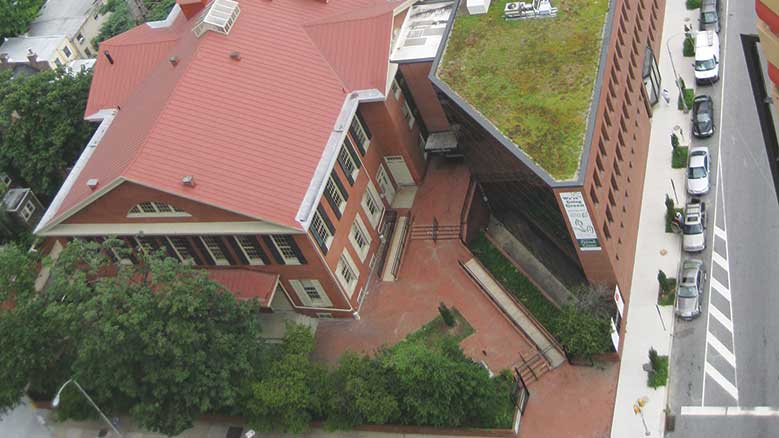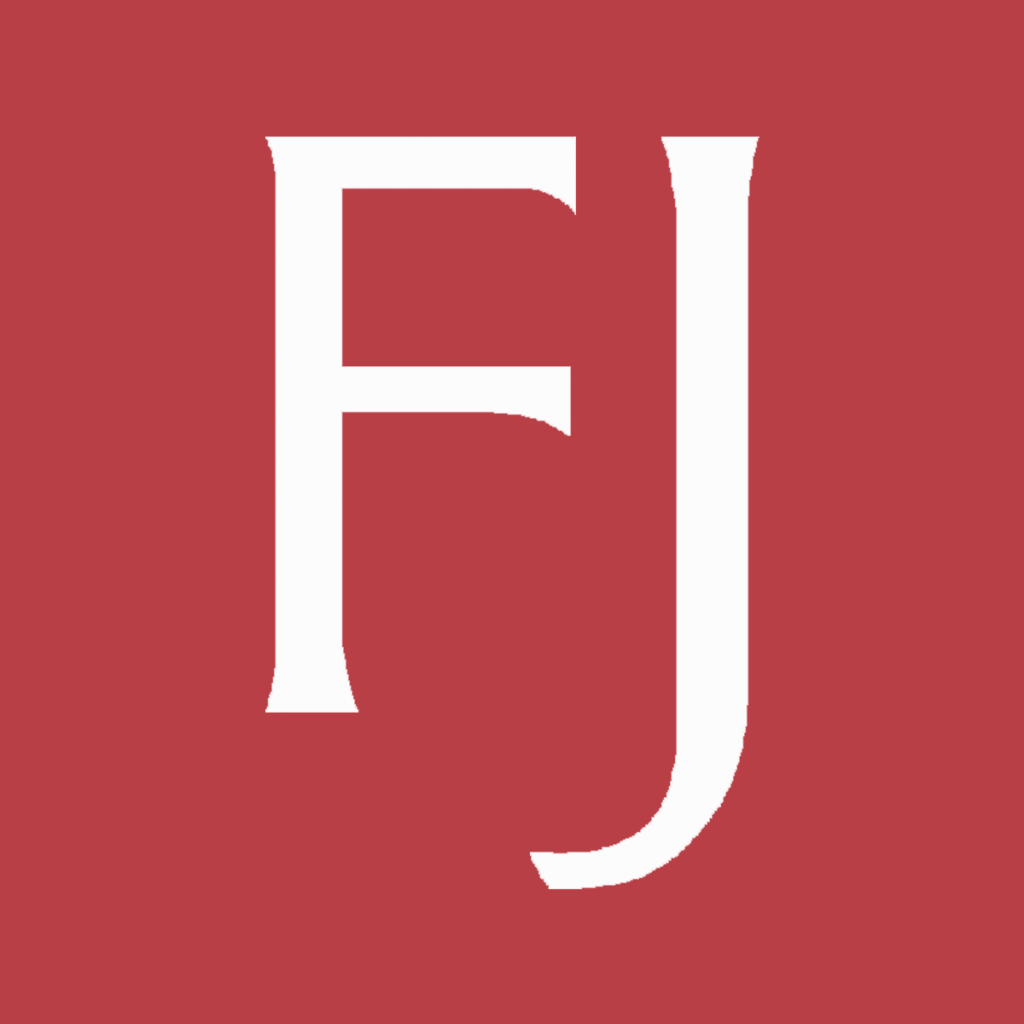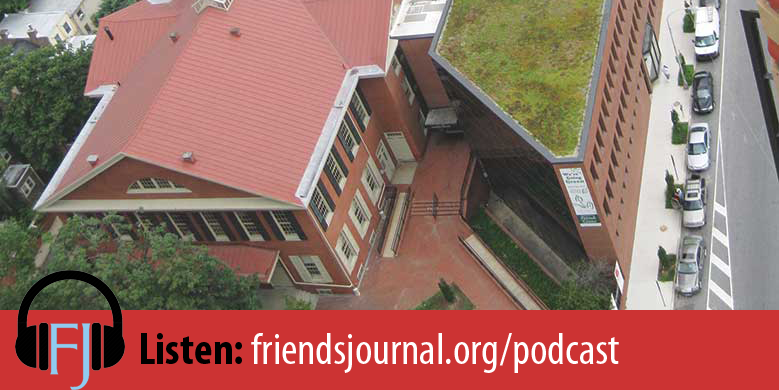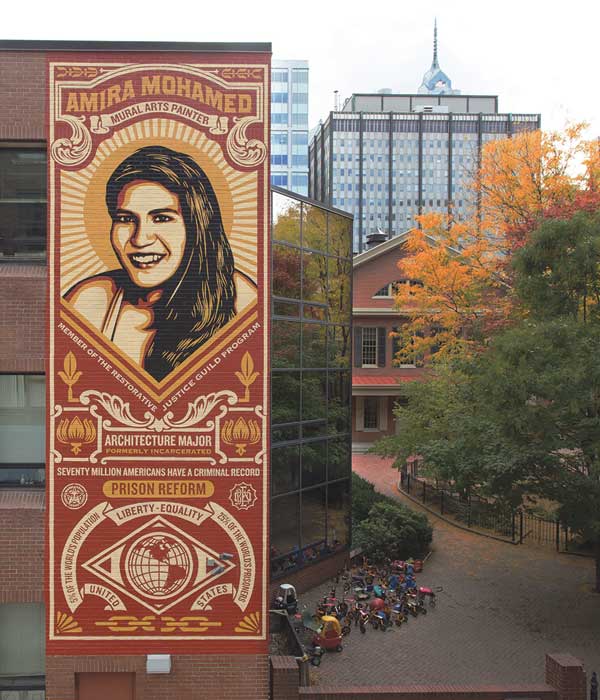
FJ PODCAST SUBSCRIPTION: ITUNES | DOWNLOAD | RSS | STITCHER
Way opens for a large public message
On October 6, 2015, I got an email from Tony Heriza, the media production director at American Friends Service Committee (AFSC). His wife, Jane Golden, directs the City of Philadelphia Mural Arts Program, and they had a problem.
Mural Arts was preparing a citywide exhibition of public art called “Open Source,” featuring pieces by several national artists. Shepard Fairey, known for his 2008 Hope poster of then-Senator Barack Obama and the Obey Giant line of art and clothing, had created a mural addressing mass incarceration.
Heriza’s email informed me that the owner of the building where the mural was going to be mounted had changed his mind, deeming it “too political.” I manage Friends Center, the three-building Quaker complex in Center City, Philadelphia, that houses AFSC along with a number of other organizations. As a member of a working group to redesign the lobby, Heriza knew we were actively exploring Friends Center’s visual displays.
The curator of the Open Source exhibition, Pedro Alonzo, came to see the site and told Fairey it could work, but the artist was initially skeptical. The different proportions of our wall wouldn’t work with his original design.
The mural, The Stamp of Incarceration, was a portrait of a young woman, Amira Mohamed, displayed as if on a postage stamp. Having returned from incarceration, Amira is part of Mural Arts’s Restorative Justice Program and studies architecture at Community College of Philadelphia. Below her portrait, the mural caption reads: “United States: 5 percent of the world’s population, 25 percent of the world’s prisoners.” This caption made it “too political” for the original property’s owner.
I was excited about the opportunity to display this mural at a Quaker space. I engaged the Friends Center board of directors, who were excited by the idea. Christie Duncan-Tessmer, general secretary of Philadelphia Yearly Meeting, commented, “I think it’s awesome. If anything, it isn’t strong enough.”
Pedro Alonzo was excited. His son had been a student at Cambridge Friends School, and he knew about Quakers’ long history of work on criminal justice issues. He conveyed all this to Fairey, including Christie’s comment. Fairey was finally convinced that Friends were serious, that Quaker values resonated with his personal values, and that Friends Center was a good location for his piece.
The mural went up over two days this past October. The Mural Arts Program organized a media tour of the works in the Open Source exhibition, with an interview of Shepard Fairey in the courtyard of Friends Center. That evening and the next day, the print, broadcast, and online coverage all carried photos of the work and credited Friends Center with hosting it.
A few months later the mural dedication ceremony was held in the Race Street Meetinghouse at Friends Center. Amira Mohamed shared her story of becoming involved with the Restorative Justice Program and agreeing to be featured in a piece that reveals she was incarcerated. Having this mural at this Quaker space has been a great opportunity for visibility of Friends—and for an issue that we care about!
Quaker crossroads
Few locations in the United States would better qualify as a Quaker space than Friends Center. The physical and spiritual heart of the three-building complex is the Race Street Meetinghouse. Registered as a national historic landmark, it was built in 1856 to serve as the Hicksite yearly meeting site. Today it is the home of Central Philadelphia Monthly Meeting (CPMM).
On one side of the meetinghouse is 1520 Race Street, a large brick townhouse built in the 1840s. Until 1922 it was used by Friends’ Central School.
On the other side is 1501 Cherry Street, a plain, brick-faced office building constructed in 1974 and renovated in 2009 to the LEED Platinum standard of green building. It serves as the global headquarters of American Friends Service Committee and as the office for staff of Philadelphia Yearly Meeting.
All told, today there are over 40 tenant organizations, Quaker and non-Quaker, whose missions complement and support Quaker values and testimony.
Friends Center is open and usually busy seven days a week, some 355 days a year. Not too many congregationally based properties, let alone Quaker meetinghouses, can claim the same.
The site is owned and managed by Friends Center Corporation, a nonprofit partnership of AFSC, Central Philadelphia Meeting, and Philadelphia Yearly Meeting formed in 1972 specifically to steward the property.
Friends Center is a crossroads where many Quakers and like-minded and like-hearted people come together. In addition to the three partner groups, there are five other Quaker organizations on site: Friends Association for Higher Education, Friends Council on Education, Friends World Committee for Consultation (Section of the Americas), Philadelphia Quarterly Meeting, and the Tract Association of Friends.
The Friends Child Care Center is a tenant, created as a co-op by parents working for AFSC and other organizations on site. Today it is an independent nonprofit that is still governed by Quaker principles.
Some 35 other tenant groups are working on peace, justice, the environment, and education, among other issues that resonate with Quaker values and testimony. Several of them also happen to have individual Quakers as their executive directors.
Our event and conference space is also well used by Quaker organizations. The nearby Friends Select School holds its midweek meeting for worship in the meetinghouse every Wednesday. Earth Quaker Action Team holds its monthly meetings here. Quaker groups such as Friends Life Care, Friends Mutual Health Group, and Friends Insurance Group have held meetings here recently. And in May, Friends Center hosted a design session for Pendle Hill conference center as part of their Living Building Challenge grant.
Friends Center serves as a location for racial justice work among Friends. Over the last year, AFSC has been hosting twice-monthly town hall meetings of the Coalition for REAL Justice, a local outgrowth of the Black Lives Matter movement. During the recent White Privilege Conference, held in Philadelphia this year, young adult Friends came to Friends Center for lunch one day to connect and debrief. The next day all Quakers at the conference were invited to gather at Friends Center and consider next steps for individuals and meetings.
Buildings as living witness
The physical infrastructure of Friends Center is a living witness to Quaker values of sustainability and earthcare. As mentioned, the 1501 Cherry Street office building was renovated to the LEED Platinum standard in 2009, which is rare for an existing building from the 1970s.
Green building features include location in a dense central city near all forms of transit; shower rooms for bicyclists; stormwater management through a green roof on the 1501 building and cisterns in the meetinghouse for a “graywater” system to flush toilets; solar panels; low-VOC (volatile organic compound) building finishes; compact fluorescent lights with sensors that turn lights off when rooms are unoccupied; electric power that is purchased from wind power providers; and a cutting-edge geothermal heating and cooling system.
Friends Center offers tours of its green building and Quaker meetinghouse. Recent groups include attendees of the American Institute of Architects national convention in May; students from both religion and architecture classes at the Community College of Philadelphia; English language learners from a nearby program; and the high school environmental science class as well as the entire eighth grade from Friends Select School.
Do Quakers—these Quakers—need spaces like Friends Center?
It takes a lot of resources to operate these three buildings—two of them historic structures—in the center of a major American city. One could ask: Does the Religious Society of Friends still need Friends Center?
I think this is too broad of a question. My predecessor, Patricia McBee, pointed out that Friends Center is not here for “the Quakers.” It is here for these Quakers: the partner and tenant organizations in the complex, and through them, all the Quakers who use the site for worship, work, and witness.
So yes, I do believe Friends Center is fulfilling a useful and necessary role for these Quakers, as well as the non-Quaker tenants and building users who are advancing Quaker values in Philadelphia and beyond. In fact, many of the non-Quakers are attracted to Friends Center by those values! It’s a good thing in their view to be associated with Quakers.
Yet it is also proper for Friends to periodically ask ourselves if owning this property is still what God is calling Friends to do. Is this the right property for this community of these particular Quakers and Quaker organizations at this time?
In his 2014 Swarthmore Lecture given to Britain Yearly Meeting, Quaker author Ben Pink Dandelion explained that the Large Meeting House in London was built in the 1920s in part because Friends thought they might not be able to rent anywhere else because of their views on military conscription. He looked at today’s situation: “Now we are the landlords. . . . We have trustees. . . . This may be all to the good, but we need to maintain the spiritual check and balance that will make us question each innovation.” “We need to keep discernment at the top of all our practices,” he counseled.
Friends Center, too, needs to maintain such a practice of discernment on a regular basis.
Not too silent: opportunities for witness, visibility, and marketing
Friends Center’s current business model relies on rental income from tenants and event users to defray the cost of operating and maintaining the facilities. Our marketing work has focused on increasing our visibility, both physically on site for visitors and passersby and through a growing social media presence focused on reaching nonprofits in the Philadelphia region as potential customers.
Fortunately, Friends Center is just two blocks from City Hall, and it is even visible from three large city municipal government buildings. Our location provides great opportunities for physical visibility for Quakers in the city of brotherly love and sisterly affection.
However, Friends Center’s appearance from the curb is demure, to say the least. While the southeast-facing main gate at the corner of Fifteenth and Cherry Streets says, “Welcome to Friends Center,” the thousands of daily drivers traveling southbound on Fifteenth Street would have to look back over their shoulders to see it.
Inside the front gate, there is an important but very subdued witness: a sculpture of early Quaker martyr Mary Dyer by Sylvia Shaw Judson. It is a replica of the one on the grounds of the Massachusetts Statehouse. It is a focal point for the entry; children from the child care center like to climb it and even sit on her lap. Mary Dyer was killed by the criminal justice system of the time, so it provides a symbolic connection to issues AFSC and other groups at Friends Center are working on today. Visually though, while the bronze image is sublime, it is not attention-getting.
Increasing curb appeal
To increase the visual appeal to tenants and guests, I developed a plan to improve the lobby, which now includes a series of banners about Quaker testimonies and values. We decided to take the SPICES words (simplicity, peace, integrity, community, equality, sustainability) and add “worship,” “justice,” and “Friends.” The new materials were installed by designer Steve Tucker in January. The color scheme is bright and vibrant. The photos on the display boards show Quakers in various stages of contemplation, action, and recreation.
Staying spiritually grounded on these grounds
Wandering around the site with a camera to take pictures of maintenance issues, I have discovered so many pockets of beauty at Friends Center: the contrast between the historic brick architecture and the stone, steel, and glass skyscrapers of Center City behind them; the blooming of the flowers and trees on the grounds; the pigeon carcasses occasionally left by a Cooper’s hawk, reminding us nature is in the city, too; the people of many backgrounds coming through the door to worship, work, or witness here.
Diego Navarro of Santa Cruz (Calif.) Meeting recently visited Friends Center during the White Privilege Conference. “It seems like a welcoming place,” he said. “Things are alive, and really important work being done in the community is being supported. It feels very open.” I agree. I have truly grown to love this quirky place, its history, its architecture, and its people.
Friends Center Timeline
1856: Philadelphia Yearly Meeting (Hicksite) builds Race Street Meetinghouse.
1917: AFSC is founded on site.
1924: Friends’ Central School moves from the 1520 Race Street building.
1955: The Race Street (Hicksite) and Twelfth Street (Orthodox) meetings combine to form Central Philadelphia Meeting; they choose to consolidate at Race Street starting in January 1956.
1972: The Philadelphia Redevelopment Authority uses eminent domain to tear down the buildings along Fifteenth Street for a road-widening project to create an exit ramp for the Vine Street Expressway. Included is a portion of a former Friends’ Central building owned by AFSC and the Whittier Hotel, a building originally built by the Philadelphia Young Friends’ Association in 1913.
1972: Friends Center Corporation is formed to own the property from Race to Cherry and from Fifteen Street to the backs of properties on Mole Street. Plan is created to build a new office building.
1974: 1501 Cherry Street is completed with offices for American Friends Service Committee and Philadelphia Yearly Meeting.
2009: 1501 Cherry Street building and Race Street Meetinghouse are renovated; 1501 earns LEED Platinum certification.
2011: The Occupy Philadelphia movement uses Friends Center as base of support.
2015: Shepard Fairey mural is installed.















Would have been nice to include a photo of the mural (if there was one it was not identified as such).